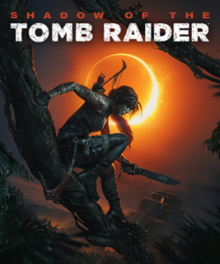
Shadow of the Tomb Raider summary and review
I absolutely loved the 2013 Tomb Raider reboot, until that point I had only been an on and off casual fan of the series. I’d played the groundbreaking first title, but It wasn’t until Tomb Raider Legend was released in 2006 that I really got my hands on another title in the series, which was the first to be developed by Crystal Dynamics rather than Core Design. I played the subsequent Anniversary and Underworld, which I liked without really loving either of them.
With the changing state of the games industry and the brand in dire need of being relevant again, the developers took a bit of a hiatus to change things up. Although it might lack in certain areas of what we’d expect from a Tomb Raider game, and the emphasis moved further into the action genre, as a package I thought the reboot worked wonders. The exploration was great, the platforming always intuitive, and the combat was fun and rewarding.
The sequel, Rise of the Tomb Raider was more expansive with a semi open world, as well as a richer upgrade system. Overall it was a more than worthy sequel, hampered slightly by its meek story, wasted early Syria section and the overall locale nowhere near as interesting as the first game.
So now we have Shadow of the Tomb Raider, the last in this reboot trilogy of Lara Croft’s pseudo origin story. On the whole I thoroughly enjoyed the game, in comparison with the others it represents the best and worst of the trilogy.
This will not be like the majority of my reviews, I will instead narrow it down to what I liked about the game and where things could have been better, because there’s only one minor aspect of the game that I out and out didn’t like.
The good:
Raiding tombs is pivotal:
One criticism you could lob at the 2013 reboot was the fact that the tombs were optional for the most part, this didn’t change much with the sequel, although the tombs were woven into the locales far better. Shadow’s has the best of both worlds, there are plenty of optional tombs that you can explore as part of the progression. While the narrative that drives the story forward is set within contained environments that require a lot more puzzle solving.
Combat takes a backseat, compared with the last two it’s surprisingly sparse, and when it does occur, it focuses far more on stealth. You can go all out, guns blazing but you’ll only make it harder for yourself.
The stealth is serviceable, it’s pretty basic but effective. Lara now has the ability to cover herself in mud and hide within the settings foliage, you can then kill off enemies with the simple press of one button when they are close-by. The kill animations are quite entertaining, but the stealth does the job and not much else.
The environments are incredible and interesting:
The game is set in two locations, beginning in Mexico and then to Peru for the vast majority of the game. Like the two previous games in the series, the locales are rich in detail and elegant to the eye. While there is no breathtaking individual moments like the first time you saw the Mongol ship hanging from the frozen waterfall in Rise. But overall I would say that Shadow’s has the most alluring, intriguing setting in the trilogy. There is a far more diverse range of topography, as you’ll explore the underbelly of a dark and atmospheric jungle, to climbing along sunlit vistas.
In the past two games the settings never really had a location that was brimming with life, none felt like places that people had lived in. Shadow’s changes this in two ways, first, the game begins in a small Mexican town where the day of dead celebrations are taking place. It’s only a short section but it’s a situation we haven’t seen in this reboot trilogy. Secondly, the biggest hub in the game, Paititi, is a little more packed and filled with human life.
Platforming is the best it has ever been:
With the combat taking more of a backseat, the exploration has a bigger role, with the platforming as good as it has ever been. At heart, right from its birth two decades ago, Tomb Raider has always been an exploration game, traversing its level design has always been the highlight. And the same is no different for this game, using the pick axe or the bow to get from one place to the next is still intuitive and a joy to do. All of the tools from the previous games return with the inclusion of a rope ascender that allows you to pull down from higher reaches. It’s hardly a game changer but it gives the platforming a little more immersion, especially when you consider that the tombs are far better this time around. I also have to applaud how agile Lara is to control, the feel of the character has the perfect balance in weight and movement.
Where improvements could have been made
The story is weak, and Lara’s characterization is inconsistent:
The stories in the reboot trilogy are good on paper but mediocre in execution, and I think they have gradually got worse with each entry. The first game masked a lot of these issues because there was a sense of urgency as the whole plot unfolded, seeing as you were in the shoes of an inexperienced and stranded Lara. In the background was also the pursuit of a mythical Japanese queen that gave the narrative a bit of gravitas.
In Shadow’s, Lara is in pursuit of Trinity (a secretive organisation that steals ancient artefacts), and she ends up having to stop an impending apocalypse. The story just never really feels convincing, so it’s hard to ever get invested in it.
The characters are even more of a problem, and they have been from the beginning of the trilogy. Jonah is the only one aside from Lara who has appeared in each game, and to be fair he’s a sympathetic character whose had a bigger role in each subsequent game. He is Lara’s moral guidance, a wrench on her recklessness, he also appears to be the only confident in her life, so the chemistry between the two works really well.
But Lara is a bit of a paradox in this one, in the earlier games, particularly the first one, she had a certain innocence to her. I sympathised with her despite the fact that you kill countless amounts of in-game enemies. But in this version she is entirely in pursuit of selfish needs, the opening section of the game in Mexico is a perfect example of this. There is also an uncomfortable rambo type moment at one point, that felt out of place not only from a gameplay point of view, but it precedes in an awkward moment of brutality.
Although she gradually grows as a character, it’s really hard to care for her, and she’s kind of unlikable for the majority of the story. The ending implies that she has learned from her mistakes, but I think it’s a little unfortunate that the developers too often reduced her to a two dimensional, action hero archetype.
The gameplay is sometimes far too scripted:
It might just be that I have seen the series do the same old tricks before, but there were far too many scripted setpieces in this one, and outside of one particular moment in Mexico, all of them are boring. As I said, this wouldn’t be too much of a problem if we hadn’t seen them done to death in the previous games.
The game’s pacing is a little all over the place, and I’m not just talking about the plot. Having gone back to the previous two games in the trilogy, it’s noticeable how much you could play for long stretches without any interruption to the flow of the game, and this includes the story. When its at its absolute height, Shadow’s has some of the best moment to moment gameplay in the trilogy, but there is far too many interruptions to the game that grinds it to a sudden halt. On too many occasions it felt like the game was playing me rather than the other way round.
The skill tree feels superfluous:
I won’t dwell on this too much, but not only is the skill tree ugly but its actual impact on the game is minimal, by the end only about two or three skills I’d upgraded felt like they had any impact. Which is a shame because I thought the skills and upgrade system in Rise was not only user friendly, but it got the right balance between making the upgrades noticeably impactful, while giving the player a certain level of agency in the way that they wanted to approach the game.
The skill tree isn’t helped by the sparse combat in the game, which is why I find it baffling that you have four weapon slots. As much as I loved the focus on platforming and exploration, the game could have done with a bit more moment to moment action that didn’t include forced stealth.
The bad
The final boss:
So bad I really don’t want to go into the details.
Final word:
If you liked the previous two games in the series, Shadow of the Tomb Raider is a must buy, despite its flaws it’s still a damn, good game. I’d rank it third in the trilogy, only just behind Rise. It certainly left me the most conflicted out of the three games, it’s also one of the few games of this generation that I have an urge to play for a second time. Just to see if I come away with different feelings on the experience.
In regard to the future of the franchise, I’m stuck in two minds, because there’s a part of me that would love to see this Lara Croft return, and see her go onto more adventures. But at the same time I know a more interesting character can be created, either way I hope a new Tomb Raider isn’t too far into the future. I’d like to see a more bright, vibrant setting, perhaps in Egypt or India. While the reboot trilogy has been visually impressive, a lot of it has been quite grim and dark to say the least.

